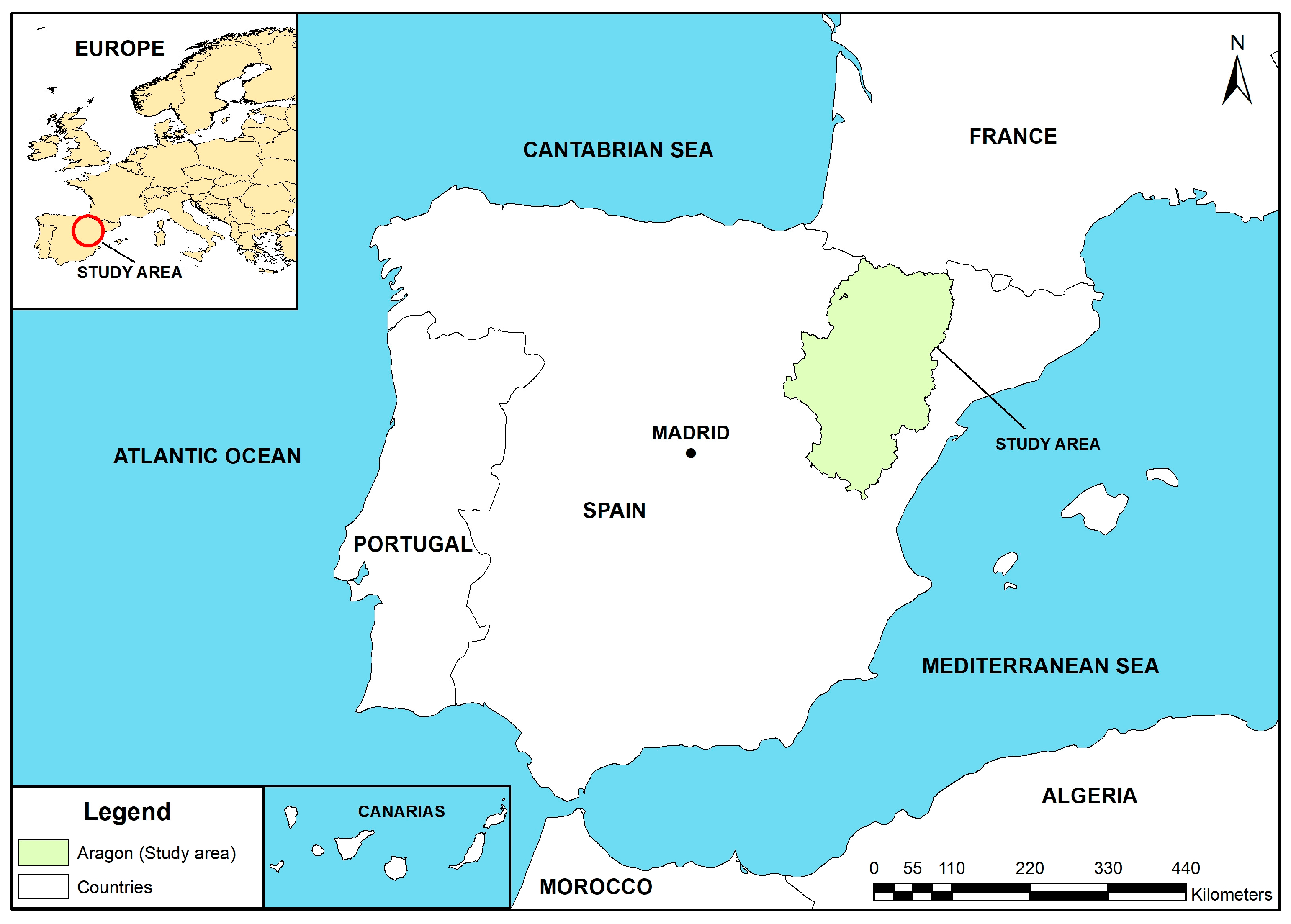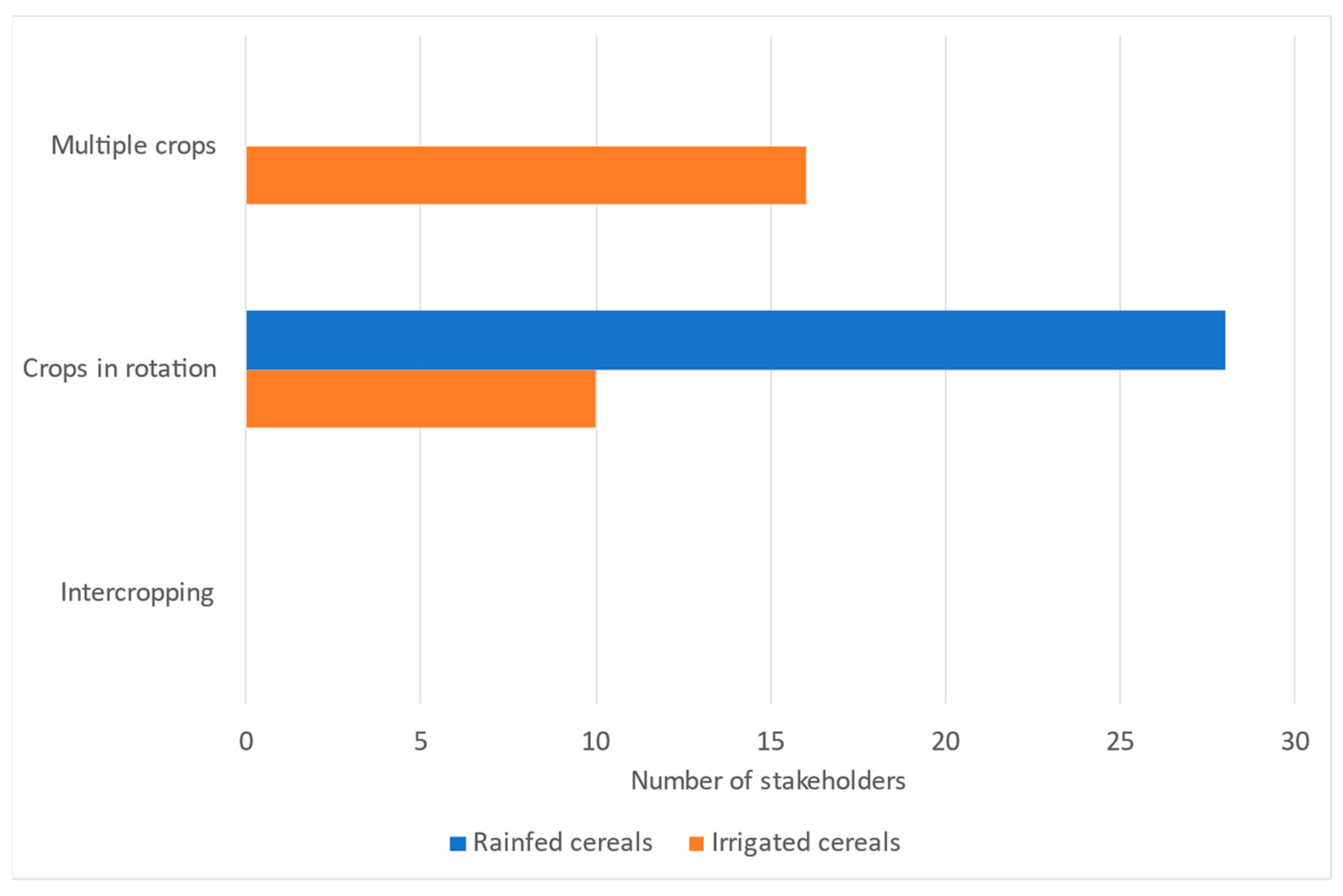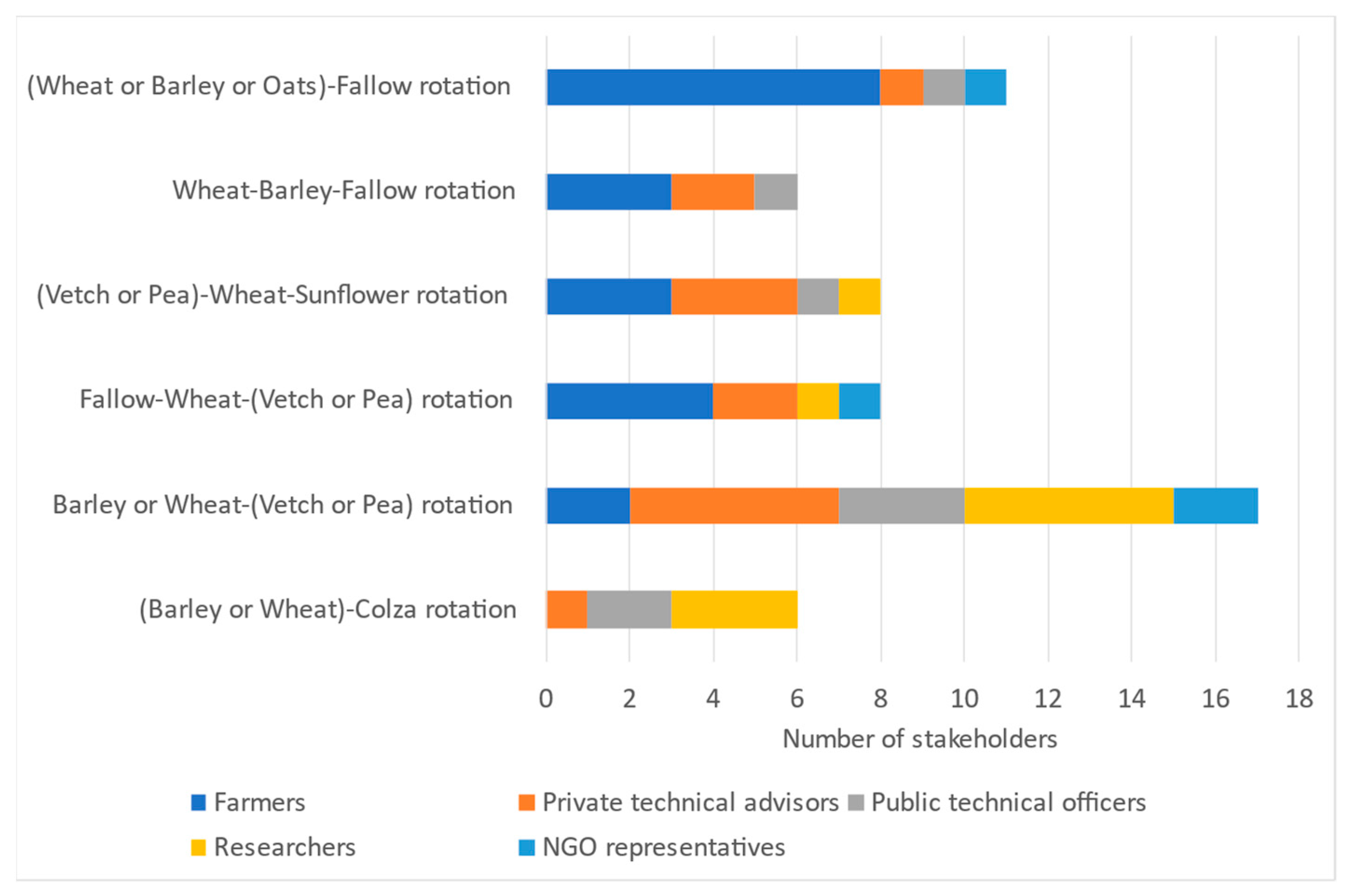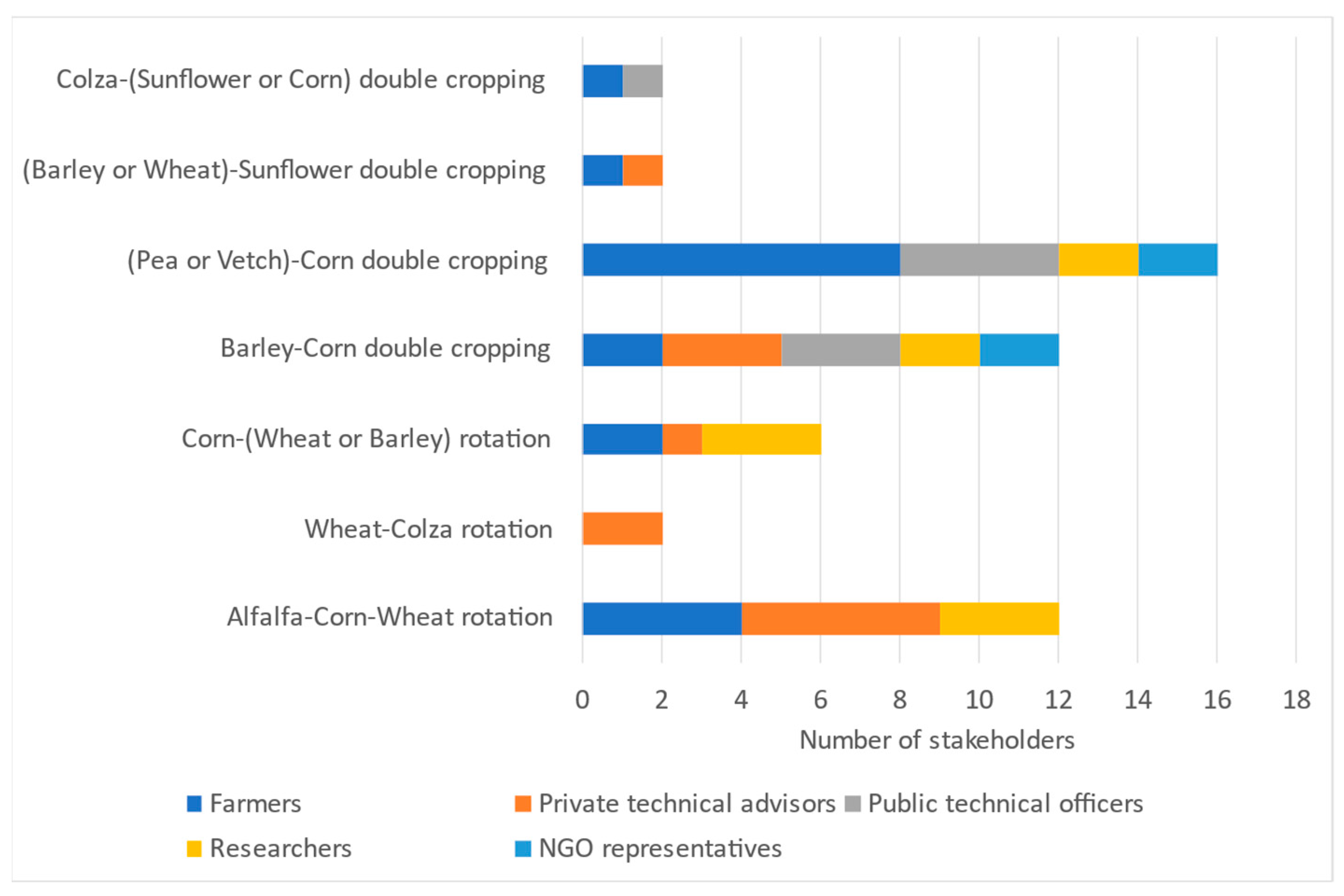Stakeholders’ Preferences for Sustainable Agricultural Practices in Mediterranean Cereal Cropping Systems
Abstract
1. Introduction
2. Materials and Methods
2.1. Cereal Production in the Area of Study
2.2. Survey Questionnaire
- Stakeholder’s characteristics;
- Qualitative assessments of the relevance of problems in each cropping system and of the priority given to possible actions to address these problems (objectives), with the option to propose additional problems or actions that they deemed appropriate;
- Identification of agricultural practices considered as suitable for the characteristics of each cereal cropping system, and of the reasons for perceiving some of these as non-suitable, again with the option to propose other practices;
- Qualitative assessment of how effective these practices are in contributing to advancing towards the consecution of each priority for action (objective).
- Simultaneous/intercalated crops (intercropping) in the same plot;
- Crops in rotation in different years;
- Multiple crops (succession of crops within the same year).
2.3. Statistical and Multicriteria Analysis
3. Results and Discussion
3.1. Survey Respondents
3.2. Perception of Problems and Priorities
3.3. Suitable Farming Practices
3.4. Effectiveness of Farming Practices
3.5. Most Suitable Type of Diversification
3.6. Most Appropriate Diversification Crops
4. Conclusions
Supplementary Materials
Author Contributions
Funding
Institutional Review Board Statement
Informed Consent Statement
Data Availability Statement
Acknowledgments
Conflicts of Interest
References
- FAO. FAOSTAT. Food and Agricultural Organization of the United Nations Statistical Database. Available online: www.fao.org/faostat/en/ (accessed on 29 April 2025).
- MAPA. Anuario de Estadística 2021 [2021 Statistical Yearbook]; Ministerio de Agricultura, Pesca y Alimentación: Madrid, Spain, 2021. [Google Scholar]
- Tita, D.; Mahdi, K.; Devkota, K.P.; Devkota, M. Climate Change and Agronomic Management: Addressing Wheat Yield Gaps and Sustainability Challenges in the Mediterranean and MENA Regions. Agric. Syst. 2025, 224, 104242. [Google Scholar] [CrossRef]
- Moreno, F.; Arrúe, J.L.; Cantero-Martínez, C.; López, M.V.; Murillo, J.M.; Sombrero, A.; López-Garrido, R.; Madejón, E.; Moret, D.; Álvaro-Fuentes, J. Conservation Agriculture Under Mediterranean Conditions in Spain. In Biodiversity; Biofuels; Agroforestry and Conservation Agriculture. Sustainable Agriculture Reviews No. 5; Lichtfouse, E., Ed.; Springer: Dordrecht, The Netherlands, 2011; pp. 175–193. ISBN 978-90-481-9512-1. [Google Scholar]
- McAneney, K.; Arrúe, J. A Wheat-Fallow Rotation in Northeastern Spain: Water Balance-Yield Considerations. Agronomie 1993, 13, 481–490. [Google Scholar] [CrossRef]
- Martínez-Mena, M.; Carrillo-López, E.; Boix-Fayos, C.; Almagro, M.; García Franco, N.; Díaz-Pereira, E.; Montoya, I.; de Vente, J. Long-Term Effectiveness of Sustainable Land Management Practices to Control Runoff, Soil Erosion, and Nutrient Loss and the Role of Rainfall Intensity in Mediterranean Rainfed Agroecosystems. Catena 2020, 187, 104352. [Google Scholar] [CrossRef]
- Bienes, R.; Marques, M.J.; Sastre, B.; García-Díaz, A.; Esparza, I.; Antón, O.; Navarrete, L.; Hernánz, J.L.; Sánchez-Girón, V.; Sánchez Del Arco, M.J.; et al. Tracking Changes on Soil Structure and Organic Carbon Sequestration after 30 Years of Different Tillage and Management Practices. Agronomy 2021, 11, 291. [Google Scholar] [CrossRef]
- Sombrero, A.; de Benito, A. Carbon Accumulation in Soil. Ten-Year Study of Conservation Tillage and Crop Rotation in a Semi-Arid Area of Castile-Leon, Spain. Soil Tillage Res. 2010, 107, 64–70. [Google Scholar] [CrossRef]
- Neto, C.; Catarino, A.; Sobreiro, J.; das Dores, J.; Patanita, M.; Tomaz, A.; Palma, P. Effect of Different Irrigated Crop Successions on Soil Carbon and Nitrogen–Phosphorus–Potassium Budget Under Mediterranean Conditions. Agriculture 2024, 14, 1908. [Google Scholar] [CrossRef]
- López-Bellido, L.; López-Bellido, R.; Fernández-García, P.; Muñoz-Romero, V.; Lopez-Bellido, F.J. Carbon Storage in a Rainfed Mediterranean Vertisol: Effects of Tillage and Crop Rotation in a Long-Term Experiment. Eur. J. Soil Sci. 2020, 71, 472–483. [Google Scholar] [CrossRef]
- Singh, S.R.; Yadav, P.; Singh, D.; Tripathi, M.K.; Bahadur, L.; Singh, S.P.; Mishra, A.; Kumar, S. Cropping Systems Influence Microbial Diversity, Soil Quality and Crop Yields in Indo-Gangetic Plains of India. Eur. J. Agron. 2020, 121, 126152. [Google Scholar] [CrossRef]
- Rosenzweig, S.T.; Fonte, S.J.; Schipanski, M.E. Intensifying Rotations Increases Soil Carbon, Fungi, and Aggregation in Semi-Arid Agroecosystems. Agric. Ecosyst. Environ. 2018, 258, 14–22. [Google Scholar] [CrossRef]
- Pareja-Sánchez, E.; Plaza-Bonilla, D.; Álvaro-Fuentes, J.; Cantero-Martínez, C. Is It Feasible to Reduce Tillage and N Use While Improving Maize Yield in Irrigated Mediterranean Agroecosystems? Eur. J. Agron. 2019, 109, 125919. [Google Scholar] [CrossRef]
- Lecina, S.; Isidoro, D.; Playán, E.; Aragüés, R. Irrigation Modernization and Water Conservation in Spain: The Case of Riegos Del Alto Aragón. Agric. Water Manag. 2010, 97, 1663–1675. [Google Scholar] [CrossRef]
- Yagüe, M.R.; Quílez, D. Pig Slurry Residual Effects on Maize Yields and Nitrate Leaching: A Study in Lysimeters. Agron. J. 2015, 107, 278–286. [Google Scholar] [CrossRef]
- Sanz-Cobena, A.; Lassaletta, L.; Aguilera, E.; del Prado, A.; Garnier, J.; Billen, G.; Iglesias, A.; Sánchez, B.; Guardia, G.; Abalos, D.; et al. Strategies for Greenhouse Gas Emissions Mitigation in Mediterranean Agriculture: A Review. Agric. Ecosyst. Environ. 2017, 238, 5–24. [Google Scholar] [CrossRef]
- Castañeda, C.; Herrero, J.; Latorre, B. Chapter Six—The Vanishing Legacy of Soil Salinity Data from Irrigated Districts: A Case Study from Spain and a Call for Action. In Advances in Agronomy; Sparks, D.L., Ed.; Academic Press: Cambridge, MA, USA, 2020; Volume 161, pp. 325–355. ISBN 978-0-12-820765-9. [Google Scholar] [CrossRef]
- Hirich, A.; Choukr-Allah, R.; Ezzaiar, R.; Shabbir, S.A.; Lyamani, A. Introduction of Alternative Crops as a Solution to Groundwater and Soil Salinization in the Laayoune Area, South Morocco. Euro-Mediterranean J. Environ. Integr. 2021, 6, 52. [Google Scholar] [CrossRef]
- Tamburini, G.; Bommarco, R.; Wanger, T.C.; Kremen, C.; van der Heijden, M.G.A.; Liebman, M.; Hallin, S. Agricultural Diversification Promotes Multiple Ecosystem Services without Compromising Yield. Sci. Adv. 2020, 6, eaba1715. [Google Scholar] [CrossRef]
- Rakotomalala, A.A.N.A.; Ficiciyan, A.M.; Tscharntke, T. Intercropping Enhances Beneficial Arthropods and Controls Pests: A Systematic Review and Meta-Analysis. Agric. Ecosyst. Environ. 2023, 356, 108617. [Google Scholar] [CrossRef]
- Hunter, M.C.; Smith, R.G.; Schipanski, M.E.; Atwood, L.W.; Mortensen, D.A. Agriculture in 2050: Recalibrating Targets for Sustainable Intensification. Bioscience 2017, 67, 386–391. [Google Scholar] [CrossRef]
- Arrúe, J.L.; Álvaro-Fuentes, J.; Plaza-Bonilla, D.; Villegas, D.; Cantero-Martínez, C. Managing Drylands for Sustainable Agriculture. In Innovations in Sustainable Agriculture; Farooq, M., Pisante, M., Eds.; Springer International Publishing: Cham, Switzerland, 2019; pp. 529–556. ISBN 978-3-030-23169-9. [Google Scholar]
- Francaviglia, R.; Almagro, M.; Vicente-Vicente, J.L. Conservation Agriculture and Soil Organic Carbon: Principles, Processes, Practices and Policy Options. Soil Syst. 2023, 7, 17. [Google Scholar] [CrossRef]
- Iakovidis, D.; Gadanakis, Y.; Park, J. Farm-Level Sustainability Assessment in Mediterranean Environments: Enhancing Decision-Making to Improve Business Sustainability. Environ. Sustain. Indic. 2022, 15, 100187. [Google Scholar] [CrossRef]
- Molénat, J.; Barkaoui, K.; Benyoussef, S.; Mekki, I.; Zitouna, R.; Jacob, F. Diversification from Field to Landscape to Adapt Mediterranean Rainfed Agriculture to Water Scarcity in Climate Change Context. Curr. Opin. Environ. Sustain. 2023, 65, 101336. [Google Scholar] [CrossRef]
- Li, Y.; Helfenstein, J.; Swart, R.; Levers, C.; Mohr, F.; Diogo, V.; Bürgi, M.; Williams, T.G.; Zafeiriou, R.; Zarina, A.; et al. Agroecological and Technological Practices in European Arable Farming: Past Uptake and Expert Visions for Future Development. Land Use policy 2025, 153, 107553. [Google Scholar] [CrossRef]
- Prokopy, L.S.; Floress, K.; Arbuckle, J.G.; Church, S.P.; Eanes, F.R.; Gao, Y.; Gramig, B.M.; Ranjan, P.; Singh, A.S. Adoption of Agricultural Conservation Practices in the United States: Evidence from 35 Years of Quantitative Literature. J. Soil Water Conserv. 2019, 74, 520–534. [Google Scholar] [CrossRef]
- Thompson, B.; Leduc, G.; Manevska-Tasevska, G.; Toma, L.; Hansson, H. Farmers’ Adoption of Ecological Practices: A Systematic Literature Map. J. Agric. Econ. 2024, 75, 84–107. [Google Scholar] [CrossRef]
- Di Bene, C.; Dolores Gómez-López, M.; Francaviglia, R.; Farina, R.; Blasi, E.; Martínez-Granados, D.; Calatrava, J. Barriers and Opportunities for Sustainable Farming Practices and Crop Diversification Strategies in Mediterranean Cereal-Based Systems. Front. Environ. Sci. 2022, 10, 861225. [Google Scholar] [CrossRef]
- Marenya, P.P.; Kassie, M.; Jaleta, M.; Rahut, D.B.; Erenstein, O. Predicting Minimum Tillage Adoption among Smallholder Farmers Using Micro-Level and Policy Variables. Agric. Food Econ. 2017, 5, 12. [Google Scholar] [CrossRef]
- Ha, T.M.; Manevska-Tasevska, G.; Weih, M.; Hansson, H. Heterogeneity in Farmers’ Stage of Behavioural Change in Intercropping Adoption: An Application of the Transtheoretical Model. Agric. Food Econ. 2024, 12, 12. [Google Scholar] [CrossRef]
- Gaba, S.; Lescourret, F.; Boudsocq, S.; Enjalbert, J.; Hinsinger, P.; Journet, E.P.; Navas, M.L.; Wery, J.; Louarn, G.; Malézieux, E.; et al. Multiple Cropping Systems as Drivers for Providing Multiple Ecosystem Services: From Concepts to Design. Agron. Sustain. Dev. 2015, 35, 607–623. [Google Scholar] [CrossRef]
- Roesch-Mcnally, G.E.; Basche, A.D.; Arbuckle, J.G.; Tyndall, J.C.; Miguez, F.E.; Bowman, T.; Clay, R. The Trouble with Cover Crops: Farmers’ Experiences with Overcoming Barriers to Adoption. Renew. Agric. Food Syst. 2017, 33, 322–333. [Google Scholar] [CrossRef]
- Leclère, M.; Gorissen, L.; Cuijpers, Y.; Colombo, L.; Schoonhoven-Speijer, M.; Rossing, W.A.H. Fostering Action Perspectives to Support Crop Diversification: Lessons from 25 Change-Oriented Case Studies across Europe. Agric. Syst. 2024, 218, 103985. [Google Scholar] [CrossRef]
- European Commission. The European Green Deal. COM(2019) 640 Final; European Commission: Brussels, Belgium, 2019. [Google Scholar]
- European Commission. A Farm to Fork Strategy for a Fair, Healthy and Environmentally-Friendly Food System. COM(2020) 381 Final; European Commission: Brussels, Belgium, 2020. [Google Scholar]
- Khatri-Chhetri, A.; Pant, A.; Aggarwal, P.K.; Vasireddy, V.V.; Yadav, A. Stakeholders Prioritization of Climate-Smart Agriculture Interventions: Evaluation of a Framework. Agric. Syst. 2019, 174, 23–31. [Google Scholar] [CrossRef]
- Wezel, A.; Brives, H.; Casagrande, M.; Clément, C.; Dufour, A.; Vandenbroucke, P. Agroecology Territories: Places for Sustainable Agricultural and Food Systems and Biodiversity Conservation. Agroecol. Sustain. Food Syst. 2016, 40, 132–144. [Google Scholar] [CrossRef]
- Roesch-McNally, G.E.; Arbuckle, J.G.; Tyndall, J.C. Barriers to Implementing Climate Resilient Agricultural Strategies: The Case of Crop Diversification in the U.S. Corn Belt. Glob. Environ. Change 2018, 48, 206–215. [Google Scholar] [CrossRef]
- Mortensen, D.A.; Smith, R.G. Confronting Barriers to Cropping System Diversification. Front. Sustain. Food Syst. 2020, 4, 564197. [Google Scholar] [CrossRef]
- Gaffney, J.; Bing, J.; Byrne, P.F.; Cassman, K.G.; Ciampitti, I.; Delmer, D.; Habben, J.; Lafitte, H.R.; Lidstrom, U.E.; Porter, D.O.; et al. Science-Based Intensive Agriculture: Sustainability, Food Security, and the Role of Technology. Glob. Food Sec. 2019, 23, 236–244. [Google Scholar] [CrossRef]
- Hossard, L.; Blanc, L.; Touama, R.; Rezgui, F.; Lehnhardt, F.; Kherif, O.; Lampurlanés, J.; Latati, M.; Plaza-Bonilla, D. Participatory Design and Assessment of Diversified Mediterranean Cropping Systems—Method and Results for Two Case Studies. In Proceedings of the 7th International Workshop for Farming System Design. Designing Climate Smart Agricultural Systems for a Sustainable Transformation of the Agri-Food Systems of the Dry Areas, Marrakech, Morocco, 30 October–3 November 2022. [Google Scholar]
- Mamassi, A.; Balaghi, R.; Devkota, K.P.; Bouras, H.; El-Gharous, M.; Tychon, B. Modeling Genotype × Environment × Management Interactions for a Sustainable Intensification under Rainfed Wheat Cropping System in Morocco. Agric. Food Secur. 2023, 12, 22. [Google Scholar] [CrossRef]
- EU CAP Network EIP-AGRI Project Database. Available online: https://eu-cap-network.ec.europa.eu/projects/search_en (accessed on 27 April 2025).
- AEMET Valores Climatológicos Normales [Average Climatic Values]. Available online: www.aemet.es/es/serviciosclimaticos/datosclimatologicos/ (accessed on 13 January 2023).
- Francaviglia, R.; Álvaro-Fuentes, J.; Di Bene, C.; Gai, L.; Regina, K.; Turtola, E. Diversified Arable Cropping Systems and Management Schemes in Selected European Regions Have Positive Effects on Soil Organic Carbon Content. Agriculture 2019, 9, 261. [Google Scholar] [CrossRef]
- Skulmoski, G.J.; Hartman, F.T.; Krahn, J. The Delphi Method for Graduate Research. J. Inf. Technol. Educ. Res. 2007, 6, 1–21. [Google Scholar] [CrossRef]
- Okoli, C.; Pawlowski, S.D. The Delphi Method as a Research Tool: An Example, Design Considerations and Applications. Inf. Manag. 2004, 42, 15–29. [Google Scholar] [CrossRef]
- Sturgis, P.; Roberts, C.; Smith, P. Middle Alternatives Revisited: How the Neither/nor Response Acts as a Way of Saying “I Don’t Know”? Sociol. Methods Res. 2012, 43, 15–38. [Google Scholar] [CrossRef]
- Munda, G.; Nijkamp, P.; Rietveld, P. Information Precision and Evaluation Methods. In Efficiency in the Public Sector; Giardina, E., Williams, A., Eds.; Edward Elgar: Cheltenham, UK, 1993; pp. 43–64. [Google Scholar]
- Calatrava, J.; Martínez-Granados, D.; Zornoza, R.; González-Rosado, M.; Lozano-García, B.; Vega-Zamora, M.; Gómez-López, M.D. Barriers and Opportunities for the Implementation of Sustainable Farming Practices in Mediterranean Tree Orchards. Agronomy 2021, 11, 821. [Google Scholar] [CrossRef]
- Hwang, C.-L.; Yoon, K. Multiple Attribute Decision Making. Methods and Applications; Springer: Berlin/Heidelberg, Germany, 1981; ISBN 978-3-540-10558-9. [Google Scholar]
- Zeleny, M. Multiple Criteria Decision-Making; McGraw-Hill: New York, NY, USA, 1982; ISBN 978-0070727953. [Google Scholar]
- Lai, Y.-J.; Liu, T.-Y.; Hwang, C.-L. TOPSIS for MODM. Eur. J. Oper. Res. 1994, 76, 486–500. [Google Scholar] [CrossRef]
- Shih, H.S.; Shyur, H.J.; Lee, E.S. An Extension of TOPSIS for Group Decision Making. Math. Comput. Model. 2007, 45, 801–813. [Google Scholar] [CrossRef]
- Hernánz, J.L.; Girón, V.S.; Cerisola, C. Long-Term Energy Use and Economic Evaluation of Three Tillage Systems for Cereal and Legume Production in Central Spain. Soil Tillage Res. 1995, 35, 183–198. [Google Scholar] [CrossRef]
- Lampurlanés, J.; Plaza-Bonilla, D.; Álvaro-Fuentes, J.; Cantero-Martínez, C. Long-Term Analysis of Soil Water Conservation and Crop Yield under Different Tillage Systems in Mediterranean Rainfed Conditions. Field Crops Res. 2016, 189, 59–67. [Google Scholar] [CrossRef]
- Hamza, M.A.; Anderson, W.K. Soil Compaction in Cropping Systems: A Review of the Nature, Causes and Possible Solutions. Soil Tillage Res. 2005, 82, 121–145. [Google Scholar] [CrossRef]
- Gonzalez-Sanchez, E.J.; Veroz-Gonzalez, O.; Blanco-Roldan, G.L.; Marquez-Garcia, F.; Carbonell-Bojollo, R. A Renewed View of Conservation Agriculture and Its Evolution over the Last Decade in Spain. Soil Tillage Res. 2015, 146, 204–212. [Google Scholar] [CrossRef]
- Plaza-Bonilla, D.; Arrúe, J.L.; Cantero-Martínez, C.; Fanlo, R.; Iglesias, A.; Álvaro-Fuentes, J. Carbon Management in Dryland Agricultural Systems. A Review. Agron. Sustain. Dev. 2015, 35, 1319–1334. [Google Scholar] [CrossRef]
- Soane, B.D.; Ball, B.C.; Arvidsson, J.; Basch, G.; Moreno, F.; Roger-Estrade, J. No-till in Northern, Western and South-Western Europe: A Review of Problems and Opportunities for Crop Production and the Environment. Soil Tillage Res. 2012, 118, 66–87. [Google Scholar] [CrossRef]
- Duru, M.; Therond, O.; Martin, G.; Martin-Clouaire, R.; Magne, M.A.; Justes, E.; Journet, E.P.; Aubertot, J.N.; Savary, S.; Bergez, J.E.; et al. How to Implement Biodiversity-Based Agriculture to Enhance Ecosystem Services: A Review. Agron. Sustain. Dev. 2015, 35, 1259–1281. [Google Scholar] [CrossRef]
- Kremen, C.; Miles, A. Ecosystem Services in Biologically Diversified versus Conventional Farming Systems: Benefits, Externalities, and Trade-Offs. Ecol. Soc. 2012, 17, 40. [Google Scholar] [CrossRef]
- Lee, H.; Lautenbach, S.; Nieto, A.P.G.; Bondeau, A.; Cramer, W.; Geijzendorffer, I.R. The Impact of Conservation Farming Practices on Mediterranean Agro-Ecosystem Services Provisioning—A Meta-Analysis. Reg. Environ. Change 2019, 19, 2187–2202. [Google Scholar] [CrossRef]
- Beillouin, D.; Ben-Ari, T.; Malézieux, E.; Seufert, V.; Makowski, D. Positive but Variable Effects of Crop Diversification on Biodiversity and Ecosystem Services. Glob. Change Biol. 2021, 27, 4697–4710. [Google Scholar] [CrossRef]
- Lin, B.B. Resilience in Agriculture through Crop Diversification: Adaptive Management for Environmental Change. Bioscience 2011, 61, 183–193. [Google Scholar] [CrossRef]
- Sisquella, M.; Lloveras, J.; Santiveri, P.; Alvaro, J.; Cantero, C. Técnicas de Cultivo Para La Producción de Maíz, Trigo y Alfalfa En Regadíos Del Valle Del Ebro [Cropping Management Techniques for Maize, Wheat, and Alfalfa Production in the Irrigated Areas of the Ebro Valley]; Proyecto Trama-LIFE: Lleida, Spain, 2004; ISBN 84-688-7860-X. [Google Scholar]
- Oubenali, A.; El Moukhtari, A.; Lamsaadi, N.; Beraouz, A.; Mouradi, M.; Ghoulam, C.; Farissi, M. The Potential Role of Durum Wheat–Chickpea Intercropping in Promoting Plant Growth and Yield in Low Soil Phosphorus Availability under Field Conditions. Euro-Mediterranean J. Environ. Integr. 2024, 9, 1325–1345. [Google Scholar] [CrossRef]





| Rainfed Cereals | Irrigated Cereals | |
|---|---|---|
| Total number of respondents | 28 | 26 |
| Farmers | 10 | 9 |
| Technical advisors | 7 | 6 |
| Researchers | 5 | 5 |
| Public agricultural officers | 4 | 4 |
| NGO representatives | 2 | 2 |
| Problems | Rainfed Cereals | Irrigated Cereals | ||||
|---|---|---|---|---|---|---|
| Average | Median | Stand. Dev. | Average | Median | Stand. Dev. | |
| Loss of soils organic matter | 3.61 | 4.00 | 0.99 | 3.73 | 4.00 | 0.92 |
| Loss of profitability/farm abandonment | 3.46 | 4.00 | 1.45 | 3.65 | 4.00 | 1.32 |
| Excessive use of fertilisers | 3.43 | 3.00 | 0.84 | 3.46 | 3.00 | 0.86 |
| Excessive use of phytosanitary products | 3.18 | 3.00 | 0.86 | 3.31 | 3.00 | 0.74 |
| Soil erosion | 3.11 | 3.00 | 1.20 | 3.23 | 3.00 | 1.14 |
| Water pollution | 3.00 | 3.00 | 1.33 | 3.04 | 3.00 | 1.37 |
| Excessive water application | - | - | - | 2.81 | 3.00 | 1.39 |
| Excessive machinery use | 2.57 | 2.50 | 1.03 | 2.54 | 2.50 | 1.03 |
| Loss of biodiversity | 2.35 | 2.00 | 1.09 | 2.38 | 2.00 | 1.13 |
| Landscape degradation | 2.33 | 2.00 | 0.96 | 2.36 | 2.00 | 0.99 |
| Soil pollution | 2.29 | 2.00 | 1.12 | 2.31 | 2.00 | 1.12 |
| Waterlogged soils | 1.39 | 1.00 | 1.03 | 1.38 | 1.00 | 1.06 |
| Actions | Rainfed Cereals | Irrigated Cereals | ||||
|---|---|---|---|---|---|---|
| Average | Median | Stand. Dev. | Average | Median | Stand. Dev. | |
| Increase farm profitability | 4.37 | 5.00 | 5.00 | 4.32 | 5.00 | 1.38 |
| Improve the soil structure | 4.32 | 5.00 | 5.00 | 4.31 | 5.00 | 1.19 |
| Increase soil fertility | 4.25 | 5.00 | 5.00 | 4.23 | 5.00 | 1.24 |
| Reduce erosion | 4.18 | 5.00 | 5.00 | 4.19 | 5.00 | 1.20 |
| Reduce energy consumption | 4.14 | 5.00 | 5.00 | 4.15 | 5.00 | 1.29 |
| Increase crop yields | 3.96 | 5.00 | 5.00 | 3.88 | 4.50 | 1.45 |
| Modernisation of agriculture | 3.86 | 4.00 | 5.00 | 3.77 | 4.00 | 1.21 |
| Increase biodiversity | 3.52 | 4.00 | 4.00 | 3.48 | 4.00 | 1.23 |
| Increase carbon sequestration | 3.38 | 3.00 | 3.00 | 3.42 | 3.00 | 1.14 |
| Conserve traditional landscapes | 3.04 | 3.00 | 4.00 | 2.92 | 3.00 | 1.32 |
| Recover traditional crops | 2.54 | 2.50 | 2.00 | 2.54 | 2.50 | 1.25 |
| Reduce flooding in fields | 2.33 | 3.00 | 3.00 | 2.24 | 2.00 | 1.59 |
| Farming Practices | Rainfed Cereals (28 Respondents) | Irrigated Cereals (26 Respondents) |
|---|---|---|
| Tillage | ||
| Minimum tillage | 85.71 | 76.92 |
| No-tillage with chemical weed control | 67.86 | 61.54 |
| Tillage following contour lines | 57.14 | 19.23 |
| Tillage with light implements | 46.43 | 53.85 |
| Conservation tillage with grazing | 39.29 | 23.08 |
| No-tillage with mechanical weed management | 21.43 | 19.23 |
| Soil coverage | ||
| Natural vegetation or cover crops | 46.43 | 42.31 |
| Mulching | 25.00 | 34.62 |
| Vegetation strips between crop lines | 7.14 | 7.69 |
| Control of soil erosion | ||
| Natural vegetation on the edges of parcels | 53.57 | 42.31 |
| Vegetated erosion barriers | 14.29 | 19.23 |
| Small stonewalls | 10.71 | 7.69 |
| Hedges on the edges of parcels | 7.14 | 7.69 |
| Non-vegetated erosion barriers | 3.57 | 7.69 |
| Fertilisation | ||
| Addition of organic matter/manure | 82.14 | 73.08 |
| Combining organic and mineral fertilization | 75.00 | 84.62 |
| Precision agriculture to optimise fertilisation | 71.43 | 80.77 |
| Green manure | 67.86 | 69.23 |
| Use of biostimulants and biofertilizers | 10.71 | 30.77 |
| Pest control | ||
| Integrated pest control | 85.71 | 88.46 |
| Crop scheduling and technologies | ||
| Crop diversification | 85.71 | 84.62 |
| Changing crop rotations | 82.14 | 73.08 |
| Sprinkler irrigation | - | 80.77 |
| Farming Practices | Rainfed Cereals (28 Respondents) | Irrigated Cereals (26 Respondents) |
|---|---|---|
| Tillage | ||
| Minimum tillage | 0.82 | 0.72 |
| No-tillage with chemical weed control | 0.63 | 0.55 |
| Tillage following contour lines | 0.49 | 0.26 |
| Tillage with light implements | 0.46 | 0.55 |
| Conservation tillage with grazing | 0.30 | 0.21 |
| No-tillage with mechanical weed management | 0.27 | 0.21 |
| Soil coverage | ||
| Natural vegetation or cover crops | 0.50 | 0.39 |
| Mulching | 0.22 | 0.22 |
| Vegetation strips between crop lines | 0.00 | 0.00 |
| Control of soil erosion | ||
| Natural vegetation on the edges of parcels | 0.54 | 0.50 |
| Vegetated erosion barriers | 0.28 | 0.24 |
| Small stonewalls | 0.20 | 0.11 |
| Hedges on the edges of parcels | 0.10 | 0.14 |
| Non-vegetated erosion barriers | 0.11 | 0.10 |
| Fertilisation | ||
| Addition of organic matter/manure | 0.92 | 0.52 |
| Combining organic and mineral fertilization | 0.69 | 0.68 |
| Precision agriculture to optimise fertilisation | 0.69 | 0.82 |
| Green manure | 0.67 | 0.62 |
| Use of biostimulants and biofertilizers | 0.31 | 0.36 |
| Pest control | ||
| Integrated pest control | 0.77 | 0.74 |
| Crop scheduling and technologies | ||
| Crop diversification | 0.74 | 0.69 |
| Changing crop rotations | 0.62 | 0.55 |
| Sprinkler irrigation | - | 0.92 |
Disclaimer/Publisher’s Note: The statements, opinions and data contained in all publications are solely those of the individual author(s) and contributor(s) and not of MDPI and/or the editor(s). MDPI and/or the editor(s) disclaim responsibility for any injury to people or property resulting from any ideas, methods, instructions or products referred to in the content. |
© 2025 by the authors. Licensee MDPI, Basel, Switzerland. This article is an open access article distributed under the terms and conditions of the Creative Commons Attribution (CC BY) license (https://creativecommons.org/licenses/by/4.0/).
Share and Cite
Calatrava, J.; Álvaro-Fuentes, J.; Martínez-Granados, D.; Franco-Luesma, S.; Gómez-López, M.D. Stakeholders’ Preferences for Sustainable Agricultural Practices in Mediterranean Cereal Cropping Systems. Sustainability 2025, 17, 4219. https://doi.org/10.3390/su17094219
Calatrava J, Álvaro-Fuentes J, Martínez-Granados D, Franco-Luesma S, Gómez-López MD. Stakeholders’ Preferences for Sustainable Agricultural Practices in Mediterranean Cereal Cropping Systems. Sustainability. 2025; 17(9):4219. https://doi.org/10.3390/su17094219
Chicago/Turabian StyleCalatrava, Javier, Jorge Álvaro-Fuentes, David Martínez-Granados, Samuel Franco-Luesma, and María Dolores Gómez-López. 2025. "Stakeholders’ Preferences for Sustainable Agricultural Practices in Mediterranean Cereal Cropping Systems" Sustainability 17, no. 9: 4219. https://doi.org/10.3390/su17094219
APA StyleCalatrava, J., Álvaro-Fuentes, J., Martínez-Granados, D., Franco-Luesma, S., & Gómez-López, M. D. (2025). Stakeholders’ Preferences for Sustainable Agricultural Practices in Mediterranean Cereal Cropping Systems. Sustainability, 17(9), 4219. https://doi.org/10.3390/su17094219








